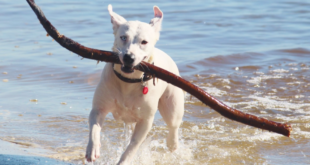The Benefits of Training Your Dog to Play Fetch – Are you a dog owner looking for an enjoyable and engaging activity to keep your furry friend physically and mentally stimulated? Look no further than training your dog to play fetch. Not only is this game incredibly fun for both you and your canine companion, but it also offers a wide range of benefits. In this article, we will explore the advantages of training your dog to play fetch and provide you with a step-by-step guide to get started.
Table of Contents
The Benefits of Training Your Dog to Play Fetch
Welcoming a dog into your family comes with great responsibility. Proper training is essential to ensure your dog’s well-being and a harmonious relationship between you and your four-legged friend. One of the most enjoyable and beneficial training activities you can engage in with your dog is playing fetch. Let’s delve into the reasons why fetch training is worth your time and effort.
Importance of Dog Training
Before we delve into the specific benefits of fetch training, let’s take a moment to understand the overall importance of dog training. Training your dog is not just about teaching them basic commands or correcting unwanted behaviors. It is an opportunity to establish a strong bond, build trust, and create a sense of structure and discipline in their lives. A well-trained dog is happier, more confident, and better equipped to navigate the world around them.
Benefits of Physical Exercise for Dogs
Dogs, like humans, require regular physical exercise to maintain their overall health and well-being. Engaging in physical activities helps prevent obesity, improves cardiovascular health, and enhances muscle tone. When it comes to exercise options for dogs, playing fetch is an excellent choice. It combines both mental and physical stimulation, making it a well-rounded form of exercise for your furry friend.
Understanding the Fetch Game
Before you begin training your dog to play fetch, it’s important to understand the mechanics of the game. Fetch involves your dog retrieving an object, typically a ball or a toy, that you throw a distance away. The goal is for your dog to bring the item back to you and release it so you can throw it again. The game taps into your dog’s natural instincts to chase, retrieve, and please their owner.
Step-by-Step Guide to Training Your Dog to Play Fetch
Now that we have a basic understanding of fetch, let’s dive into a step-by-step guide to help you train your dog to play this exciting game:
1. Choosing the Right Fetch Toys
To get started, select appropriate fetch toys for your dog. Look for toys that are easy to grip, safe for their teeth, and durable enough to withstand play sessions. Tennis balls, rubber balls, and soft frisbees are popular choices.
2. Building Your Dog’s Interest in Fetch
Before jumping into formal training, pique your dog’s interest in the fetch game. Use positive reinforcement techniques such as treats, praise, and enthusiastic encouragement to associate the game with enjoyment and rewards.
3. Teaching Basic Commands for Fetch
Begin by teaching your dog basic commands like “sit,” “stay,” and “drop it.” These commands will be instrumental in guiding their behavior during the fetch game. Practice these commands in a calm and distraction-free environment.
4. Introducing the Fetch Game
Once your dog is familiar with the basic commands, introduce the concept of fetch by rolling or tossing the toy a short distance. Encourage your dog to chase the toy and bring it back to you using positive reinforcement.
5. Encouraging Retrieval Behavior
If your dog doesn’t naturally retrieve the toy, gently guide them towards it using encouraging words and gestures. When they pick up the toy, reward them with praise and a treat. Repeat this process until they consistently retrieve the toy.
6. Reinforcing Positive Behavior
As your dog becomes more proficient at fetching, reinforce their positive behavior by gradually increasing the distance of your throws. Remember to praise and reward them each time they successfully retrieve and return the toy.
Dealing with Challenges
During the training process, you may encounter some challenges. Some dogs may struggle with dropping the toy or become easily distracted. Patience and persistence are key. Use consistent training methods, break the game into smaller steps if necessary, and provide ample rewards and encouragement to overcome any obstacles.
Expanding on the Fetch Game
Once your dog has mastered the basic fetch game, you can expand on it to add more variety and mental stimulation. Consider introducing different types of toys, hiding the toy for your dog to search and retrieve, or teaching them to fetch specific objects by name.
Alternatives to Fetch
While fetch is a fantastic game, not all dogs may take to it immediately or find it as enjoyable. If your dog doesn’t show interest or struggles with the concept, don’t worry! There are plenty of alternative activities you can explore, such as tug-of-war, scent games, or agility training. The key is to find an activity that suits your dog’s preferences and abilities.
Conclusion of The Benefits of Training Your Dog to Play Fetch
Training your dog to play fetch offers a multitude of benefits for both you and your canine companion. It provides mental and physical exercise, strengthens the bond between you, and taps into your dog’s natural instincts. Remember to approach the training process with patience, positivity, and consistency to ensure a rewarding and enjoyable experience for both of you.
FAQs
1. How long does it typically take to train a dog to play fetch? Training duration can vary depending on your dog’s age, breed, and previous training experiences. Consistent daily practice, positive reinforcement, and patience are key factors in achieving success. It may take several weeks or even months for some dogs to master the game.
2. Can any dog breed learn to play fetch? Yes, most dog breeds can learn to play fetch. However, some breeds may be more naturally inclined to retrieve objects due to their instincts. It’s important to adapt the training process to your dog’s individual needs and preferences.
3. Is fetch training suitable for older dogs? Absolutely! Fetch training can be enjoyed by dogs of all ages. For older dogs, it’s essential to consider any physical limitations they may have and adapt the game accordingly. Shorter play sessions and softer toys can be beneficial for senior dogs.
4. How often should I play fetch with my dog? The frequency of fetch sessions will depend on your dog’s energy levels and overall health. Generally, it’s recommended to engage in at least two play sessions per day. However, always monitor your dog’s behavior and adjust the frequency as needed.
5. Are there any safety precautions to keep in mind during fetch training? When playing fetch, it’s important to choose appropriate toys that are safe for your dog to chew on and avoid objects that can pose a choking hazard. Additionally, ensure you have a secure play area free from potential dangers or distractions.
Remember, the key to successful fetch training lies in creating a positive and enjoyable experience for your dog. With dedication and a bit of practice, you’ll soon be able to enjoy countless hours of fun-filled fetch sessions with your furry companion.
 Treat For Dog – Brain Training for Dogs, Dog Training & Obedience Discover Treat For Dog and get your pup on the path to smarter, happier, and healthier living with brain training for dogs.
Treat For Dog – Brain Training for Dogs, Dog Training & Obedience Discover Treat For Dog and get your pup on the path to smarter, happier, and healthier living with brain training for dogs.




